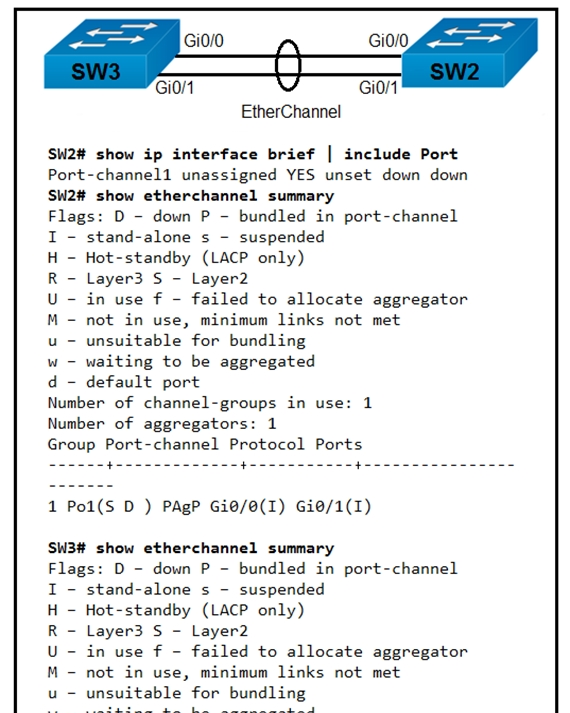
Refer to the exhibit. Which action resolves the EtherChannel issue between SW2 and SW3?

Refer to the exhibit. Which action resolves the EtherChannel issue between SW2 and SW3?
To resolve the EtherChannel issue between SW2 and SW3, it is necessary to configure both switches to use the same negotiation protocol. SW2 is currently configured to use PAgP (Port Aggregation Protocol), a Cisco proprietary protocol. To align with this, the correct action is to set SW3 to use PAgP as well. By configuring channel-group 1 mode desirable on both interfaces, we enable PAgP on SW3, ensuring compatibility and allowing the EtherChannel to function correctly. Simply, desirable mode on SW3 matches the PAgP configuration of SW2, resolving the issue. Therefore, the answer is to configure channel-group 1 mode desirable on both interfaces, which aligns with option C.
Shouldn't this be C? SW2 is using PAgP
exactly
Both r cisco sw pls check sw symbol.
May be SW3 is not a Cisco Switch? LACP Works on both CISCO and Non CISCO
The answer is C because SW2 is running PAgP (Cisco Proprietary). "channel-group 1 mode desirable" enables PAgP. "channel-group 1 mode active on" enables LACP. This also concludes that both switches are Cisco switches.
For me the answer is C, this is a cisco exam, however at least one of those switches should be cisco, and according with the picture, both outcomes are the same, so both are cisco.
The simple fact that the etherchannel bundle is showing PagP and the interfaces are showing standalone, even when connect suggest that the SW might be a different protocol. You are better off changing the channel protocol to active. I support D as the final answer.
This question is ridiculous. Both solutions can work, it depends if I have multivendor on my enviroment or not. Of course as the other says because both are Cisco switches Cisco prefer to use their own protocols....
Both C and D are correct answers, but D has a typo and the original one states group 5 instead of 1. and knowing that the answer is C.
D is correct the exhibit is not complete, here is the complete one. Switch2 #show etherchannel summary Flags: D - down P - in port-channel I - stand-alone s - suspended Number of channel-groups in use: 1 Number of aggregators: 1 Group Port-channel Protocol Ports ------+-------------+-----------+---------------------------------------------- 1 Po1(SD) PAgP Gi0/0(I) Gi0/1(I) Switch3 #show etherchannel summary Flags: D - down P - in port-channel I - stand-alone s - suspended Number of channel-groups in use: 1 Number of aggregators: 1 Group Port-channel Protocol Ports ------+-------------+-----------+---------------------------------------------- 1 Po1(SD) LACP Gi0/0(I) Gi0/1(I)
as you see, there´s a protocol mismatch on both sides. PAgP is a Cisco proprietary protocol, whereas LACP is an open standard, making LACP the preferred choice (we don´t know if SW3 is a cisco swich or not). since SW3 is configured for LACP, configuring LACP is best way to resolve this issue.
Thanks for getting full exhibit, if thats the case I'd go with D as LACP will work on both the switches.
I can't see the entire output, so I don't know the deal with SW3. But if we have PAgP configured on the SW2, then on the SW3, we must configure auto or desirable to bring etherchannel up.
mode desirable for PaGp, mode active for LACP
for me is 100% C because from the picture the switches are cisco platform
It's running PAgP.
The provided answer should be correct l, when you change the mode to on both interfaces then you will have LACP instead of PAGP.
Active mode
A problem with this question is that it does not specify what switch the proposed configuration should be on for answers C and D. Also answers C and D says both INTERFACES, not both switches. C would be correct if we're changing both interfaces on SW3 so that we match PagP on SW2. But answer D could be correct if we change both interfaces on SW2, since with the complete configuration shown for SW3 on other sites for this question, it is configured for LACP.
SW2 It's already configured with Port Aggregation Protocol as shown on the output of Show Etherchannel Summary. The question also does not specify which switch to make the configuration we are to assume it's on SW3, if we configure Active on both interfaces the Etherchannel will not bundle due to incompatible protocols Active/Passive are both configuration for LACP. Active/Passive = Bundle Active/Active = Bundle Passive/Passive = No bundle Auto/Desirable are both configurations for PAGP Auto/Desirable = Bundle Desirable/Desirable = Bundle Auto/Auto = No bundle Hope this helps.
C is correct one side (sw2) shows PAgP, so for the etherchannel works properly both sw must run the same protocol, so teh option is "desirable" Regards!
It's a cisco exam.... the question doesn't say anything about non Cisco-Switches it's C
SW2 is using PAgP and both members interface Gi0/0 and Gi0/1 are in state(I), it means they are not receiving any activity. configure channel-group 1 mode desirable on SW3.
mode desirable for PaGp, mode active for LACP